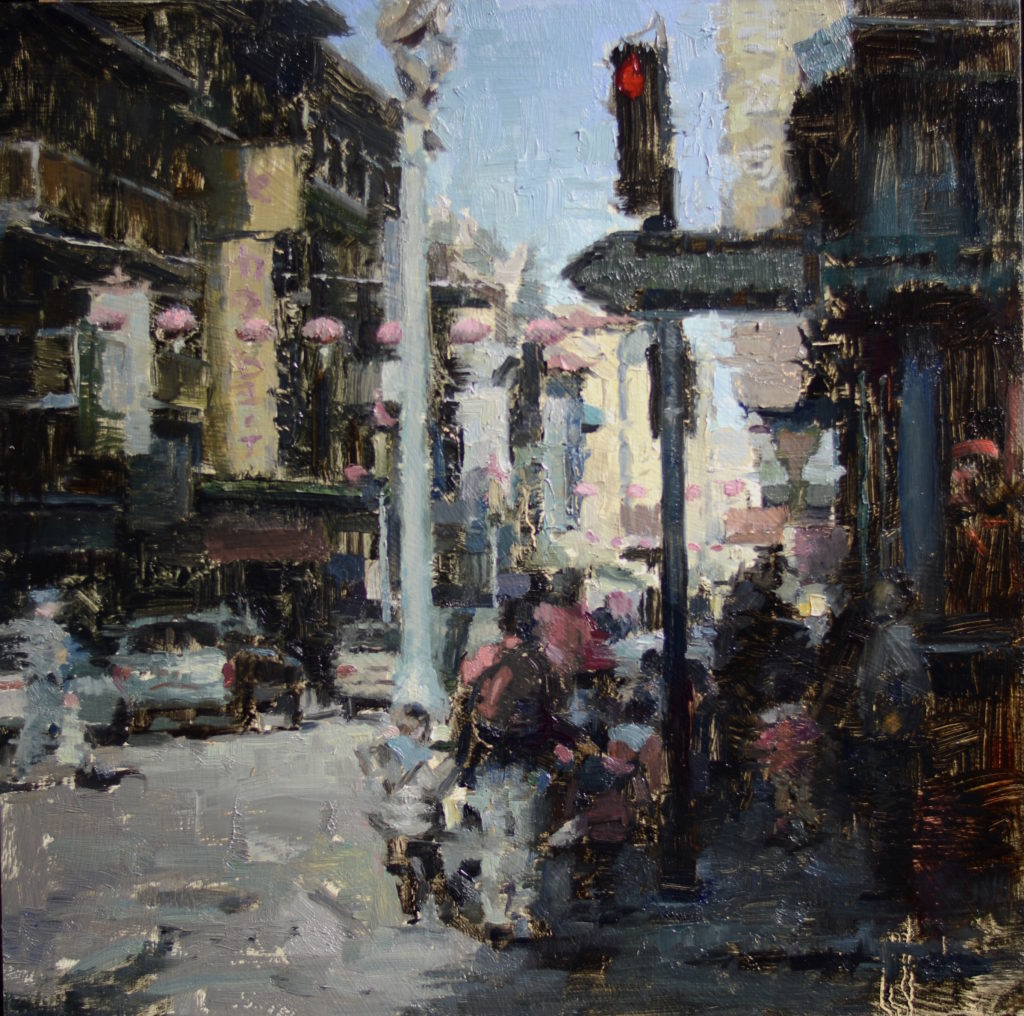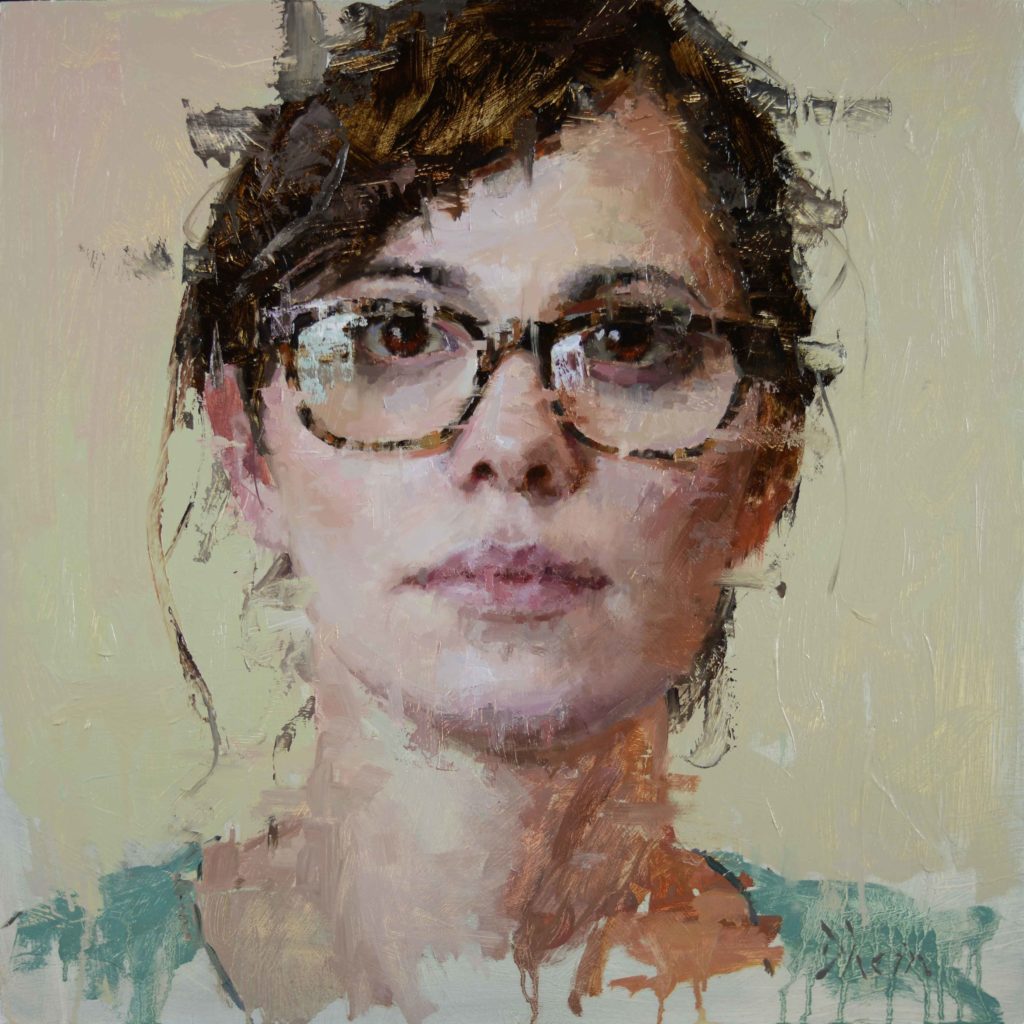From cityscapes to landscapes to figurative art, this painter shares both his inspiration and process.
The following was originally written and published in 2015
Inspiration and the Journey Through Process
BY JACOB DHEIN
Cityscapes
Living in San Francisco is a gift in itself. The city is visually one of the most amazing in the world: it has elevation fluctuations, many cultures that influence the scenery, the ocean, cliffs, and lots of fog. I often walk around the city with my camera. Once when I was walking through Chinatown I noticed that the light and shadow patterns were just amazing. I immediately started snapping photos, and as if by fate, a line of young children walked into my camera frame. The way the light and shadow bounced off the children as they walked in and out of shadow was exquisite.
Soon after downloading the images I began the painting “Chinatown.” I began with an accurate drawing of the shadow pattern and filled it in with a dark wash, allowing some of the paint to run during application. After the dark pattern, I began adding the light, and eventually worked in limited detail into the shadow. By using a pixelated or blurry look, a sense of energy and the feel of movement created the dynamics of bustling Chinatown. I was careful not to overwork the painting, and I allowed some of the underpainting to show so the viewer could see my process.



Another one of my favorite cityscape subjects is trolley cars in the rain, an iconic San Francisco image. These images have so much character and create a strong focal point. The tracks and overhead power lines act as a natural lead-in and enhance one-point perspective. The wet surface on the street is marvelous. The reflecting image suggests there is another mysterious world below the street.
“Market Trolley in the Rain II” was painted in a manner similar to “Chinatown.” In contrast to “Chinatown,” I let the underpainting dry before adding the final details. This ensured the two layers did not mix, making the paint application easier and bolder.



Landscape
Landscape painting is an exhilarating experience. It provides a sense of freedom and divinity, allowing me to bend compositions to my will. It allows me to move, change, or leave out areas without consequence. The majority of my landscapes are plein air paintings.
Several years ago a group of colleagues from AAU and I started painting together. During our plein air outings we discuss painting techniques and philosophies of art. During a plein air trip to Yosemite I remember talking with a fellow artist, James Kroner. He had the enthusiasm of a child at their first carnival when talking about photo references of rock structures he photographed at dusk. He explained why these images were so magnificent.
My eyes widened and I started seeing the forms as separate abstract elements that intricately work together. It is a great gift whenever I am able to see the world from a new perspective.

On the last day of the trip our group went on the Tioga Road and found an awe-inspiring spot. There were rock formations everywhere, making it easy to choose a proper vantage point. Finding one, I envisioned the process leading to the finished painting. I’ve found that having a preconceived notion of what I want my painting to look like significantly increases my chances of success. The site I chose had multiple natural lead-ins to the area of interest.
During the next two hours I struggled with the painting because it wasn’t quite what I envisioned. After returning to San Francisco I put the painting away for a few weeks. When I looked at it again I was surprised that all the frustration creating it seemed to have been worked out. Although it wasn’t quite what I imagined I was very happy with the finished look and it became one of my favorite plein air paintings. I think the composition is very different from other painting I have done, and the busy detail work on the top quarter portion balances out nicely with the bottom area of the simple rock formation.
On another plein air excursion we went to Fisherman’s Wharf. There are amazing areas to paint in its nooks and crannies, if you’re not afraid to explore a little. I had a studio in North Beach, only a ten minute walk from Fisherman’s Wharf, and during that time I did many paintings in and around the Wharf.
To my surprise during one visit, one of the piers under construction for so long had reopened. At the end of the pier there is a vantage point that looks out to a small building that I found fascinating. In the past I was never able to get close enough to paint it properly.
In the beginning stage of the painting I used layers of thinned paint applied with a brush to get the light and shadow pattern. Then I used a squeegee to remove some of the original wash in preparation for the lighter reflections on the bottom. I added other thin layers of paint with a palette knife, allowing the paint to drip, creating a semi-controlled chaos. This painting became my favorite plein air. The mixture of abstract and representation, the variety of applications, and the color palette make for an interesting and unique painting.

Figurative
Figurative painting is my favorite subject matter. I am fascinated by the variety of people that I encounter, and find myself staring at them at times. In these moments I am lost in thought, recreating their appearance in my head, imagining how I would paint them.
The first time I saw Theresa I found myself drawn to her eyes behind her glasses. I think the eyes can convey a sense of sadness, passion, love, calmness, awkwardness, and countless other things. Theresa’s glasses seemed to magnify the feeling that I saw in her eyes. Because she had very light flesh tones I decided to use cool natural light during the photoshoot. By doing so, I eliminated harsh shadows and kept a natural feeling to the image.

The painting “Nude in Blue II” was inspired by Ann Gale and Alex Kanevsky. I love going to the Dolby Chadwick Gallery in downtown San Francisco to see their work. This painting was started after I had a photo shoot for my figurative drawing class.
During the photo shoot I asked the model to step off the modeling stage and pose in front of it. I put a strong warm light on one side and allowed a small amount of cool natural light in the window to add diversity to the color temperature relationship. I studied the images in my studio. The background was so simple, splitting the composition in a desired ratio.
For this painting, I set aside three days to make sure I had enough time to finish it while the paint was still wet. This permitted me to blend the transitions and merge the figure into the background. The painting was finished with many different paint applications, giving a sense of vast complexity within the simple composition.



While my paintings are diverse in subject matter and sometimes in style, to me they are a collective of my experiences and inspirations during different periods of my life. Rather than writing a diary in words, my diary is in brushstrokes, paint dribbles, and palette knife marks. With my art I hope future generations will see the world as I saw it, meet the people I met, see the places I went, and know what inspired me.
Learn more about Jacob Dhein at: www.jacobdhein.com.
> Visit EricRhoads.com to learn about more opportunities for artists and art collectors, including retreats, international art trips, art conventions, and more.
> Sign up to receive Fine Art Today, our free weekly e-newsletter
> Subscribe to Fine Art Connoisseur magazine, so you never miss an issue








